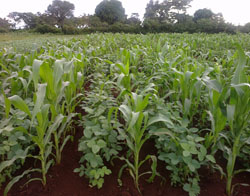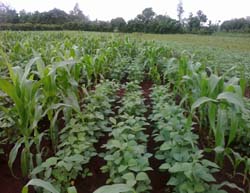Introduction
In Western Kenya less than 30% of the farm area is planted with legumes which limits the amount of nitrogen fixed by the legumes that can be beneficial to companion or subsequent crops. Successful BNF by legumes in the field depends amongst others on agronomic management, where plant density plays an important role. This prompted Margarida, a MSc Student from the University of Nairobi to test different intercropping patterns of maize and soybean to identify the practices that maximize BNF, increase yields and improve livelihoods of smallholder farmers of Western Kenya.
Research setting
Margarida is conducting a study to identify suitable planting densities of soybean and maize in the midland and upper midland zones of Western Kenya. The objective is to assess the effect of varying soybean and maize planting densities on the yields of both crops as well as on the yield from subsequent maize. Three planting densities of maize:soybean (1:1, 1:2 and 1:3) are being tested with three soybean varieties (SB 25 (NAMSOY), SB 132 (SC SQUIRE) and SB 118 (TG x 1987-18F)). As the area falls within the Striga infested zone, IR (imidazolinone-resistant) maize is used in the trials. Biomass, BNF, yields of current maize and soybean and yield of subsequent maize as well as costs involved are recorded to evaluate the effectiveness of the systems and to determine the appropriate intercropping patterns for smallholder farmers. Margarida started her field work in the 2011 short rains growing season (September-December) and her work continues into the current 2012 long rains growing season (March – June 2012).
 |
 |
 |
|
Density 1:2 All at Butere site (midland zone) |
Density 1:1 during 2012 long rains growing season |
Density 1:3
|
Preliminary results indicate that in both zones, maize: soybean planting density 1:3 provides the best soybean biomass yield (in the range of 2,000-4,000 kg/ha, depending on soybean variety and location) whereas the density 1:2 provides high grain yield of both crops (above 2,000 kg/ha of maize and 1,300 kg/ha of soybean). The research is ongoing and final results will be presented as an MSc thesis due in September 2012.
Margarida Simbine and Freddy Baijukya
